|
 Secure Site
Secure Site
|
 |
Archive for the 'teahouse' Category
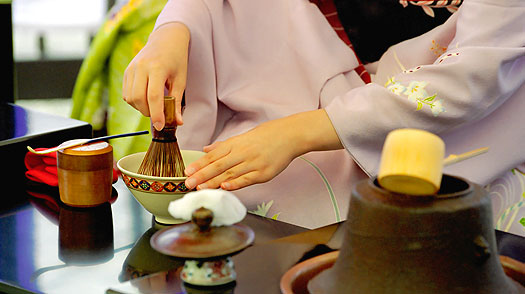 Japanese tea ceremony
Kyoto: 10 Things to Do
By ROB GOSS
Zen again, but this time in a tea cup. The cleansing of the tea utensils, the gentle bow as you receive your cup, the three clockwise turns before you take a sip: it’s not difficult to see how deeply rooted the slow and graceful movements of the tea ceremony are in Zen Buddhism. Chado or sado, as the ceremony is known, is by no means limited to Kyoto, but with the city’s rich Zen connections, it is an ideal place to experience it. Try visiting En, a small teahouse in Gion with tatami tearooms and English-speaking Kimono-clad servers. You’ll find it next to Chionin Temple, a short walk from the Chionmae bus stop on route number 206 from Kyoto Station.
1. En
272 Matsubara-cho, Higashiyama-ku, Kyoto, Japan; 81 (0)80 3782-2706 teaceremonyen.com
adapted from Time Magazine, Jan. 2012
 Zen Alarm Clock for a Gentle Awakening with Chime Now & Zen Headquarter Store
1638 Pearl Street
Boulder, CO 80302
(800) 779-6383
Posted in Chime Alarm Clocks, Tea Ceremony, teahouse
 tea and yoga Enjoyed for centuries as a healthy drink, tea also has merits as a postyoga refreshment with the ability to foster community and dialogue among students—while soothing the senses, too.
By Angela Pirisi
When students are roused from their final relaxation after a yoga session and you see them emerge glowing and peaceful from the stillness of their mat, the last thing you want to do is turn them out into the noise, chaos, and stress of the world outside the studio. It’s too jolting a contrast, and students often need some time to digest their yogic experience and slowly transition back to their daily lives. That’s why, for many yoga studios, the bridge between yoga and the high-intensity pace outside is a warm cup of tea.
Serving Health and History
Many studios serve tea, usually after class, as a way to offer students an opportunity to bask in the buzz of yoga. “People’s hearts are really opened after yoga, and tea offers a perfect segue back into their reality,” says Elissa Kerhulas, a Kundalini teacher and owner of Yoga Brew in Hollywood, California. Tea is an informal yoga tradition that has taken root over the years, and growing knowledge about the various health benefits of tea have made it a welcome addition to yoga classes as one more way to embrace healthy living. While it’s not a ritualized process per se, the tradition of combining tea and yoga has an ancient connection.
“Yoga and Ayurvedic medicine go hand in hand,” says Kerhulas, who offers tea (and/or soup) as part of her home-catered yoga classes. She remembers her Kundalini teachers talking about tea all the time. For example, “yogi tea,” a home-brewed spice tea, includes traditional Ayurvedicspices, such cloves, black pepper, cinnamon, cardamom, and ginger, in a black tea base, sweetened with milk and honey. The recipe was inspired in the 1960s by Yogi Bhajan, who served the tea to students. Many teachers, though, have stepped away from this traditional recipe and are serving up drinks that range from green tea to roasted barley to custom herbal blends.
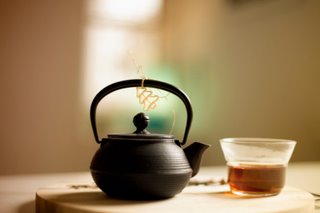 yoga and tea Kerhulas was brewing her own custom blends when she started her business six years ago, but she then started consulting a master herbalist who now intuitively assesses the best brew for each of her classes. “The kind of tea I serve depends on the people in a class, as well as the time of day,” Kerhulas explains. “For morning classes, I might start with something such as chai, ginger, or yogi tea because of their invigorating and stimulating properties. For evening classes, I would more likely choose something calming or grounding, such as jasmine, lavender, wood betony (mint family), licorice, or chamomile.” Her one-of-a-kind tea blends often combine several herbs.
Melanie Smith, an Anusara yoga teacher and owner of Yogaphoria in New Hope, Pennsylvania, offers students custom-blended teas made just for her studio, including black, green, and Rooibos teas. “Serving tea arose from the desire to serve something healthy and nurturing,” she says. On a more personal level, though, adds Smith, “I’m a big fan of tea and what it can do for the body—its healing properties and antioxidants.”
Opening Hearts and Minds
Besides soothing and healing properties, the main thrust behind a postyoga cup of tea is about the social bonding and unity it creates among students. “It’s very much about community, a chance to get to know each other, as well as a chance to be part of that energy and keep that energy, too,” says Smith. Her studio includes a space created specifically for tea, the Tea Lounge. She describes it as a place where students can study, do their work, and process what they’ve learned in classes or teacher training.
Other teachers agree that tea can help facilitate learning and discussion. Jennifer Durand, who teaches hatha yoga at the Healing Yoga Foundation in San Francisco, leads the Ladies’ Tea and Yoga Society, where students convene after her hour-long class for tea and philosophical discussion, either in the studio, which is an old greenhouse, or in the garden. Durand describes these gatherings as significantly more social than, say, a Japanese tea ceremony. “When everyone has settled, I either introduce a topic of discussion (anything from a Yoga Sutra to how we can eat more healthfully) or I let the conversation unfold on its own. Increasingly, I’ve been choosing the latter, as it seems to me that the women are enjoying the chance to connect in their own way,” says Durand.
 tea “The way the Society came about was that, of course, hatha yoga gets you only so far—it gives you a certain discipline, to be sure, and it can create a stronger, healthier body,” explains Durand. “But one must take it that extra distance for the practice to be truly transformative; one has to delve into the philosophical side of things. I find the best way to introduce the Sutra is through the gentle approach of sneaking it in with tea and treats.”
Whether used for its mystical or medicinal properties, tea has become an integral part of yoga, and students seem to have no trouble warming up to the experience.
Tips for Serving Tea
While there is no rule book for serving tea with yoga, there are some ways to enrich the experience by setting the right mood.
Invite all of the senses. Kerhulas stresses maintaining a clean, uncluttered space; adding beautiful objects (flowers, artwork); serving tea in a porcelain or wooden cup; playing light, meditative music; and using incense, such as sandalwood (which is very grounding). “Basically, it needs to feel as if you are entering a special zone that’s separate from the stresses of everyday life,” she says.
Serve only the finest tea. “Make sure to use good, loose-leaf tea to enhance the whole experience—it’s more healing and beneficial,” says Smith. On a practical note, Smith advises that if you want to use fine china, you have to clear it with the local health department. In fact, Smith says she has a restaurant license just to brew and serve tea. Using any nondisposable dishes or cutlery would require having a dishwasher and a three-basin sink. In Pennsylvania, where she is, you’re regulated as soon as you serve anything—the law could vary across the states.
Make it comfortable. It’s about creating a space where students feel welcome, loved, and nurtured, says Smith. That’s why she chose to place a large, L-shaped, lavender sofa in her Tea Lounge, custom-designed to be extra deep so students could easily sit on it in the Lotus position. Both the sofa and room are decorated with soothing, soft shades, such as sage, turmeric, and saffron.
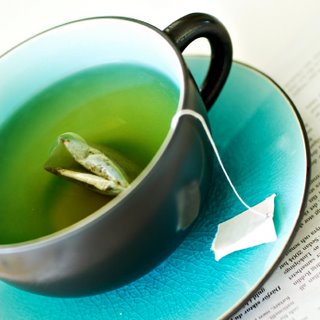 tea Pair it up with healthy food. Kerhulas serves homemade vegetarian or vegan soups (such as black bean, curried butternut squash, or potato leek). Smith says the Tea Lounge sells only green, raw, or organic snack bars and fruit—”things that enhance health, nothing processed.”
The guidelines vary by state, and maybe even by city or town, but Smith suggests that once you’re preparing and serving food or drink, you’re starting a relationship with the health department. And if you aren’t following the local laws and you’re found out, you can be reprimanded, fined, or even shut down. The best policy is transparency. Call your local health department; tell them exactly what you’re planning to do, serve, and sell; and then fill out the proper paperwork. Your best bet is to follow all relevant laws.
Angela Pirisi is a freelance health writer who has covered holistic health, fitness, nutrition, and herbal remedies. Her work has appeared in Yoga Journal as well as inNatural Health, Fitness, Cooking Light, Let’s Live, and Better Nutrition.
 bowl gong timers for tea, yoga and meditation Now & Zen, Inc.
1638 Pearl St.
Boulder, CO 80302
(800) 779-6383
adapted from Yoga Journal.com
Posted in Tea Ceremony, teahouse
 Soothing you senses with a cup of tea From its strong health properties to its millennia-old cultural history, tea provides a rich and nourishing experience in every cup. While all tea is derived from the vibrant leaves of Camellia sinensis, each variety—much like cheese and wine—has its own regional home, processing technique, and unique taste characteristics. As you discover the vast world of tea, you may develop favorite flavors and even regional loyalties (we list a global selection of organic teas below, each rich in antioxidants, amino acids, vitamins, and minerals). The journey starts by creating a personal ritual of preparation and appreciation—soothing your senses along the way.
Black
Formed by withering, rolling, oxidizing, and drying the fresh leaves, black tea today hails largely from the mountainous areas of India, Sri Lanka, and Kenya. Enjoy the touch of honey flavor in Mighty Leaf Tea’s Organic Darjeeling Estate ($12.95, 3 oz).
Oolong
Chinese and Taiwanese tea makers create the characteristically complex flavor of oolong tea—with a bouquet ranging from apricot to spice—by tossing, bruising, and roasting the leaves. For a woody flavor, try Art of Tea’s Iron Goddess of Mercy Roasted ($17, 4 oz).
Green
Fine green teas are the products of spring’s first flush, when warming weather quickly matures dormant nutrients. Minimal processing prevents oxidation, so the leaf retains its natural hue. Numi’s Monkey King Jasmine ($9.75, 4 oz) offers a crisp tea with floral high notes.
White
Slow drying gives white teas their fluffy look, and light oxidation imparts a mellow taste. Experience the delicate White Blueberry by Zhi ($23, 4 oz), brimming with antioxidants.
Pu-erh
Legend has it that the fermented flavor of pu-erh tea was discovered on the ancient Tea Horse Road connecting China and Tibet. Now gaining popularity in the West, pu-erh can be a collector’s item—sometimes aged for decades. Wild Tree Mini Tuo Cha by Arbor Teas ($22.95, 5 oz) boasts a fresh grassy taste with rich depth.
 relax and rejuvenate with a cup of tea
Did You Know? Caffeine occurs naturally in Camellia sinensis (helping the plant ward off insects), but content varies based on factors like regional agricultural conditions, type of leaf, and brewing method. On average, a cup of tea contains one-fourth to one-half the caffeine content of a cup of coffee.
Flavor Unleashed
A soothing cup of tea is the result of a dialogue between water and tea leaves. Asians refer to the process of tea steeping as “the breathing and stretching of the leaves,” according to The Tea Enthusiast’s Handbook by Mary Lou and Robert J. Heiss.
Unglazed teapots and ceramic cups with covers called gaiwans are the ideal vessels to unfurl flavor, says Mary Lou. If you’re at the office or prefer one serving, single-cup mesh filters or paper tea sacks give leaves more space to open and release flavor than do tea balls. With simple equipment, the tea cup can become your witness to a delicious conversation.
adapted from Yoga Internation by Janet Webb Lee — an acupuncturist who also studied yoga and ayurveda extensively. She practices at the Center for Health and Well Being in San Diego, CA.
 Timers with chime, perfect for timing tea
Now & Zen
1638 Pearl Street
Boulder, CO 80302
(800) 779-6383
Posted in Meditation Tools, teahouse
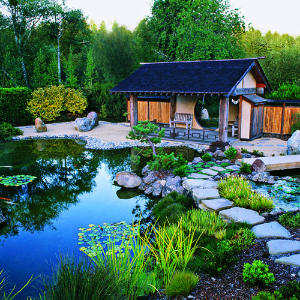 Flecked with water lilies and fringed with greenery, a heart-shaped pond exemplifies the spirit of the Osmosis Meditation Garden. A stone path leads visitors across a small bridge to the Moon Pavilion In the West, gardens are designed for outdoor living as much as for viewing. Japanese gardens, on the other hand, are more for viewing ― to communicate peace and tranquility. The new Meditation Garden at the Osmosis spa in Freestone blends the two approaches. “It’s a Japanese-style garden created for California,” says owner Michael Stusser. The design, by Robert Ketchell, founder of the British Japanese Garden Society, is Japanese, but the use of California native plants and the lovely coastal-hills setting tie it directly to the region.
What makes it so serene? A mirror-smooth pond reflects the day’s changing light and passing clouds. Plantings are simple yet sculptural: a single conifer beside a shapely boulder in one area, a Japanese maple and several conifers in another. Gravel raked in swirls around boulders evokes the feeling of water.
Like Japanese gardens, the Meditation Garden is meant to be viewed through a moon window in the pavilion near the pond. But like a California garden, it invites you in to feel the tranquility.
INFO: Osmosis: The Enzyme Bath Spa (209 Bohemian Hwy., Freestone; 707/823-8231) celebrates its 20th anniversary on Sep 9 with a concert and sushi buffet ($65); tickets limited.
Osmosis is having a 25 year anniversary celebration on September 12th with food music and complementary cedar enzyme foot baths. The cost is $25.
Garden tours are planned for every Sunday in October between 11am and 3:00pm
adapted from Sunset Magazine, by Lauren Bonar Swezey
Posted in Bamboo Chime Clocks, Hot Springs, Now & Zen Alarm Clocks, teahouse, Well-being
Kyoto meets Giverny in this artful garden, a sublime space for contemplation.
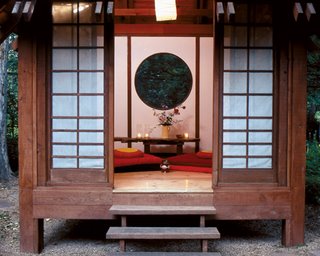 teahouse, photo by Povy Kendal Atchison Japanese shoji screens traditionally are made from translucent rice paper, but the owners chose a durable, light-penetrating fabric that will prevail in harsh weather. It allows filtered light without sacrificing privacy. The floor is salvaged pine planks from a park ranger’s mountain cabin, and a round window brings in the garden even when the doors are closed.
Ten years ago, a Boulder, Colorado, couple bought a house on a patch of grass with some overgrown shrubs, sliced by an irrigation ditch. Where many people might have seen desolation, these intrepid gardeners saw the opportunity to create a private world of solitude and renewal. In the process, they discovered that designing and planting is as soothing as enjoying the completed garden.
The contemplative garden they’ve created gently nods to Asian style while embracing European impressionism. It borrows from 19th-century impressionist painter Claude Monet, as well as from the Japanese love of plant textures, weeping trees and artfully placed rocks. It includes water, rocks, expanses of greenery and winding paths, but not the formal Japanese plantings that require so much upkeep.
Monet’s famous garden in Giverny, France, includes a Japanese bridge over a water lily pond. In this Colorado garden, a pale-aqua bridge arches over an irrigation ditch that’s been funneling water to farmers for 100 years. Just as the lily pad pond became the Monet garden’s major draw, the ditch has been transformed—lined with sandstone rocks alongside a bed of river rocks. Gold, yellow and orange daylilies drape the bank, blooming in midsummer when the Siberian and Japanese irises offer only seed pods. Ornamental grasses bend and sway to the breeze stirred up by the water’s flow. The ditch is an enticement; visitors brace against the railing and peer into the water, watching blossoms float downstream.
Every corner of this garden was designed with careful thought, not lavish funds. A decade of hard work and trial-and-error provided an education.
Piecing together elegance
Every corner of this garden was designed with careful thought, not lavish funds. A decade of hard work and trial-and-error provided an education. In hindsight, the homeowners believe their decision to tackle their garden in small pieces rather than taking on the entire half-acre saved them time, money and frustration.
“We didn’t have a grand master plan,” one of the homeowners admits. Instead, he started by clearing dead and dying trees. Then he parceled the property into smaller gardens: a ditch lined with water-loving plants and flagstones circles the edges of the gardens and is sprinkled with elfin thyme and other herbs for groundcover.
To imitate nature’s undulating, uneven landscape, he built mounds, or berms, from garden soil, adding interest to the flat piece of land. Berms also provide quick drainage for plants that might never take hold without humus and gravel. Sun-loving plants such as foxtail lilies and peonies are located on the sunny mounds. Shade-loving hostas line the flagstone walkways under giant locust trees.
“It all came together like a jigsaw puzzle,” the gardener says, with groundcovers of thyme and vinca, creeping veronica, wild strawberries and sweet woodruff. Groundcovers that can become invasive thugs, such as the sweet woodruff, were banished to the riverbank under the house, where it can duke it out with ornamental strawberries for space and light.
What’s in this garden?
• Crabapple trees (Malus spp), highly adaptable to most weather and soil conditions, have exquisite spring blooms. The weeping varieties include Red Jade, Coral Cascade, White Cascade and Louisa. Best to order from your local garden center.
• Species (or wild) tulips (Tulipa spp) have brilliant hues and hardiness. Long before more formal tulips became the backbone of Dutch gardens, miniature species tulips blanketed hillsides in Turkey. Most only can be grown in climates with winter temperatures. Order from trustworthy companies (see “Resources,” below) that propagate their own bulbs and do not harvest from the wild.
• Foxtail lilies (Eremurus spp) have attention-grabbing feathery spikes and day-glow colors. They’re easy to grow, but they do require good drainage to avoid root rot.
• Thyme (Thymus spp) may be slow to start, but once established, it tolerates some foot traffic. Best as filler between stepping stones, aromatic thymes will creep around rocks and steps, choking out weeds.
• Daylilies (Hemerocallis spp) have sweeping, grasslike foliage and arching blooms. Each blossom lasts only one day, but the plant blooms nonstop throughout summer. They require little care aside from division every few years, and only a moderate amount of water.
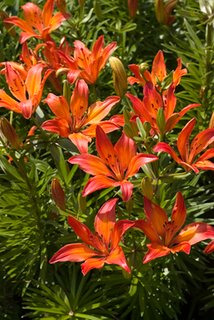 daylilies • Irises (Iris spp) are easy to grow if you choose the right cultivars for your garden. Siberian and Japanese irises grow best in moist, slightly acid soil, perhaps on the banks of a pond or stream. For alkaline soil and aridity, choose bearded irises. And if you love variegated leaves of white and green, look into Iris pallida.
• Hostas (Funkia spp), with wide, variegated leaves, add to foliage interest rather than floral displays. Lords of the shade garden, hostas can be found in a variety of sizes, some with blue-tinged or gold coloration and heart-shape leaves. All need some moisture and dappled shade.
Four seasons of splendor
In this garden, bold plants such as peonies and foxtail lilies are the prima donnas—showy and extravagant with heavy blooms. Other beauties are far smaller and require a closer look. Brilliant red and yellow species tulips—more natural looking than their formal, hybrid cousins—pop up among drifts of thyme. Delphiniums and their smaller brethren, larkspur, join foxgloves for height and extravagant color. Oriental poppies and California poppies display papery petals, popping up in mounds and drifts.
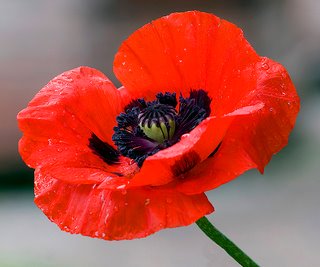 oriental poppy In early spring, the bright blues and purples of the groundcovers cluster throughout the garden, complementing the species tulips’ tiny blooms. By late spring, foxgloves and Siberian and Japanese irises dominate. Summer is golden, as daylilies offer orange, yellow and cream colors.
The garden may be at its best in winter, the gardeners claim. Japanese lanterns guide visitors down the flagstone footpath, and snow sets a black-and-white scene. Bare, weeping crabapple branches bend gracefully like sculpture. “Some of the most beautiful times in the garden are in the snow,” the homeowner says. “You see all the shapes that don’t go away: the mounds, rocks, ornaments, trellises.”
Reflecting in the teahouse
Autumn and winter usher in the garden’s quiet moments, when trowels are put away. A tiny teahouse, built of salvaged cedar siding left over after the house was built, holds sway. Once inside, a cup of hot tea banishes the cold. Sliding shoji screen doors open to the sparkling light on snow or close to keep out a brisk wind. The nine-by-nine-foot teahouse anchors this garden, a reminder that its primary purpose is to promote meditation and reflection rather than busyness. A Zen Timepiece adornes the interior so that one can timer their meditation practice. The naked branches of an old cottonwood tree loom over the teahouse while smaller pines and dwarf evergreens screen the street and neighborhood. “The teahouse gave us a focus for the garden,” the homeowner says, “and cut down the amount of lawn.”
In winter’s stillness, when birds are silent, only the bamboo wind chimes clink softly. The teahouse’s back wall features a round window that provides the most private views and connects the garden to the teahouse. “I wanted a big round window,” the owner says, “to bring the outside in.”
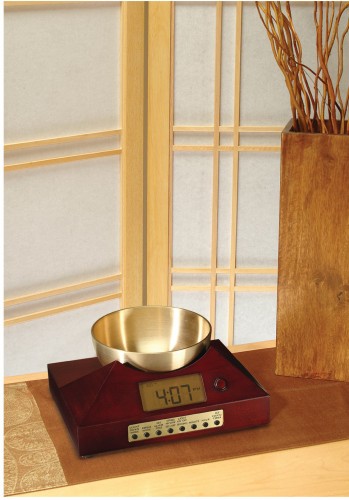 Zen Timepiece with brass singing bowl, a meditation timer. adapted from Natural Home Magazine, March/April 2008 by Niki Hayden
Now & Zen
1638 Pearl Street
Boulder, CO 80302
(800) 779-6383
Posted in Bamboo Chime Clocks, Chime Alarm Clocks, Japanese Inspired Zen Clocks, Now & Zen Alarm Clocks, teahouse, Well-being, Zen Timepiece by Now & Zen, Zen Timers
 Garden of Kokedera Temple, Kyoto 1980, Tokuriki Almost everyone has a cherished memory of sleeping outdoors. A roof of stars, a cricket lullaby, the cool air on your face, awakening to the calls of birds and the first rays of the sun. It’s a welcome relief from the confines of a square room, stale indoor smells, and noisy appliances.
One particular outdoor sleeping experience made me a believer. A friend and I were camping in late summer at the edge of a meadow in an oak woodland. We kept it simple: sleeping bags rolled out on a tarp. The first night I remember thinking, Is nature always this noisy? How am I supposed to sleep? To my city-numbed senses, it was all new: the low moan of the wind in the tree branches, the crunching footfall of small animals on dried leaves, the hoot of owls, the distant howl of coyotes. And that moon—won’t somebody turn out the light?
But by the second night, the living world had woven me into its tapestry. I fell asleep easily, held by the earth, stroked by sweet breezes, reassured by the rustling of life all around me. When we broke camp a few days later, I felt like I was being torn from maternal arms. All my cells, newly accustomed to a deep sense of homecoming, told me that something precious was being left behind.
We were made for this stuff. Our ancestors were sleeping outdoors long before there were doors to sleep out of. Our senses, our psyches, our biological clocks are attuned to the rhythms of the sun and moon and the sounds, smells, and feel of the living web. When we sleep, we renew ourselves; there is no more important time to breathe clean, cool air and hear the thrumming of nature.
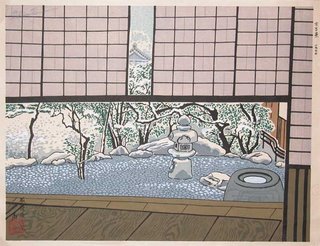 Teahouse at Daitokuji Temple, Kyoto by Tokuriki, 1977 Try this at home
If you need a breath of fresh air tonight, you can start inexpensively: Pitch a tent in the yard or pull your bed onto the deck in fair weather. I f you enjoy the experience, you may want to build a permanent sleeping porch or pavilion with a table for your portable Bamboo Zen Alarm Clock. Or you can alter an existing room to open up when the weather is pleasant; a wall of windows or doors that move aside can bring the outdoors to you.
adapted from Natural Home, July/August 2002 by Carol Venolia
 Zen Alarm Clock, Ukiyo-e Hokusai Wave Dial Face Now & Zen
1638 Pearl Street
Boulder, CO 80302
Posted in Chime Alarm Clocks, Japanese Inspired Zen Clocks, Now & Zen Alarm Clocks, Progressive Awakening, teahouse
|
|
|
|